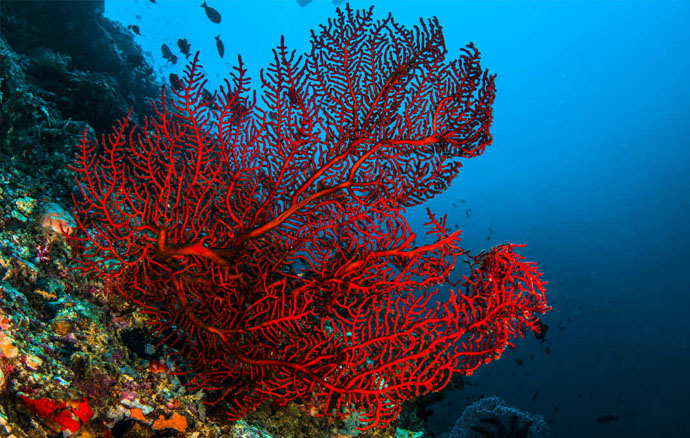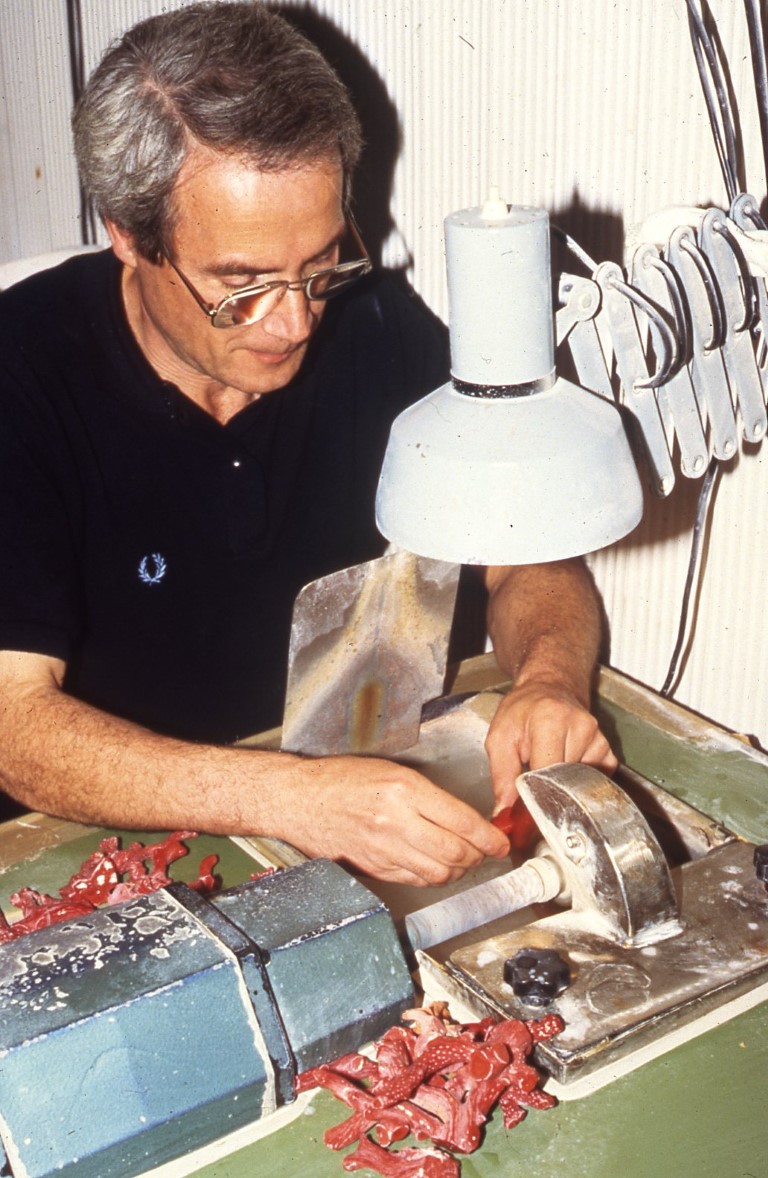WHAT IS CORAL
Coral is a symbol of metamorphosis and change. It is a natural stony substance transformed from the skeletons of small marine animals

Red coral, “Corallium rubrum”, resembles a young sapling, it reaches a maximum height of 30-35cm, and it is the only Corallium species to live in the Mediterranean Sea. For many years it was considered to be a plant because of its tree shape, or even a mineral because it is as hard as stone, however it actually belongs to the animal kingdom, classified as Anthozoa, because this coral is composed of little animals called polyps. Thousands of these polyps live on the branches of corals, they look like small round white flowers, and have eight tentacles. They produce a calcareous secretion, mostly made of carbon calcium, and this makes up the skeleton of the colony
The calcareous branches are wrapped in a casing of live tissue called coenosarc. The polyps cling to this and feed themselves through a system of canals which transfer nutrients to the rest of the polyps colony.
Corals survive in saline water that is not polluted, with reduced movement of water and soft lighting. They tend to prefer the shade and areas where they feel safe (caves, cliffs, rock crevices). They’re found generally at a depth of between 15/20 – 200 m. The calcareous skeleton produced by the plyps in the case of red coral grows only about 3-4 mm in height and about 0,25-0,60 mm in diameter a year. This makes it extremely vulnerable when it comes to coral harvesting by man.


Coral fishing in the Mediterranean Sea and the Red Sea has been active since ancient times, in the Mediterranean see during the 1800's mostly practiced by Italian fishermen from Torre del Greco, town near Naples, on the slopes of the Vesuvian volcano; but also, by the French, Spanish and the Greeks. It is, however, a relatively new activity in Japan.
Coral fishing was done in similar ways everywhere, Italian coral fishermen used a cross-shaped beam tool, nets and a ballast. Coral fishermen went by boat to coral reefs where the ropes were unwound and the coral tool was immersed until it touched the bottom; the boat was then slowly moved in various directions, and the tool would scrape the bottom, tearing the corals away, and they would then remain entangled in the nets and then be collected by the fishermen.
Fortunately, this method is no longer used, as it damaged both the marine floras and the branches of the coral which could not be repaired. Coral fishing today is delegated to expert divers with a permit, in designated areas only. The divers are careful in not causing any damage to the coral branches, the ocean floor and the small corals that are not used in commerce.


The red coral of the Mediterranean comes in different shades of red, from light to dark red. From the seas in the Far East, other species and colors are available, like the Japanese “Moro” which is very dark with traces of white (known as “soul” or “vein”), the Boke' or pale pink “Angel Skin”, which is compact and uniform, the “Cerasuolo” or “Momo” salmon coloured from pale to dark , the speckled Deep Sea pink, and the White coral.
CORAL WORKMANSHIP

The first phase after fishing consists in selecting the branches that can be worked on, and then separating them according to color, shape and dimension. After this phase, one can determine the use of the material.
Once they are cleaned with special treatments, they move onto the next phase which is complex and delicate: the cutting phase and this is handled by expert and highly experienced artisans. A good final product weighs about 30-35% of the rough product, and any margin of error decreases the quantity of this precious material.
There are two techniques in coral workmanship:
-the smooth technique used to create spheres, cabochons and other geometric shapes
- the incision technique which is used to create sculptures and larger and more complex shapes
After the cutting phase, in the smooth technique, the coral is shaped and the artisan starts working the coral.
The coral is then purified with a sanding technique until it takes its final shape


If necessary, the pieces can be drilled with water-cooled drills with through-holes or half-holes.
The corals are then selected according to quality, size and color before becoming necklaces, earrings, rings and so on.
Artisans, on the other hand, must be very skillful when selecting coral for engravings as they must choose branches from the raw product that will allow them to create the desired shape. Engravings are done solely by hand using a burin.
The final step is the polishing phase which is done also by hand using special brushes.
.jpg)















